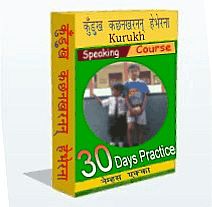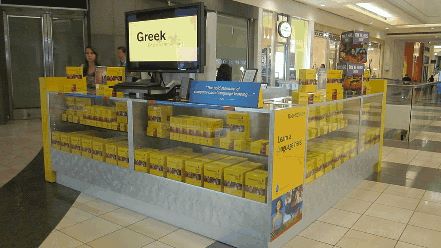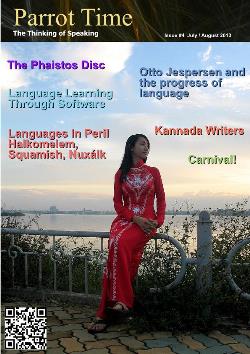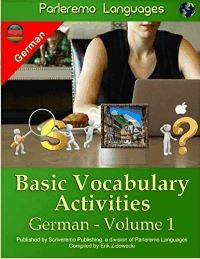
|
Transparent Language I first used Transparent Language software back in the early 1990s, and I was impressed with their approach. Like Rosetta Stone, they didn't focus on teaching vocabulary and grammar. Instead, they attempted to teach the user through another attempt at immersion, this time using readings. There are a few problems with this process, however. First of all, it is a false sense of accomplishment. The basic process of the program was to present the student with a body of text, such as a story, in the target language. The student would then try to read it. If they didn't understand a word, he or she could click on it and get a translation. This approach is definitely more aimed at the advanced learner. It is also a varient on the dual-language books. One could use this process with other media, like books and newspapers, using a dictionary to look up what isn't known. The drawback to that is that constantly looking up words stunts the flow of learning, so having it incorporated into interactive software is a much better application. Another version of Transparent Language software exists in their Foreign Language Series. This one incorporates entire lessons using the same process, giving the meaning of the word as well as the entire phrase when an word is highlighted. It also displays any grammar rules attached to the word, such as verb tense, and allows a student to play a recording of the word spoken, the entire phrase spoken, or to read the entire lesson out audibly. The recording is done by a native speaker, not synthesized, which allows a student to hear how the words sound so they get a direct connection between the written and spoken. This playback ability alone shows how much more versatile software can be, as compared to other methods like audio and books. Both of those methods utilize one aspect, but rarely both. The software allows a person to replay any part as many times as they want instantly. The software offers much more than just this capability, however. It also offers some basic games, such as crosswords, plug-n-play, unscramble, vocabulous, and segment unscramble. The crossword is straightforward fill in the words to complete the sentence clue. The plug-n-play has a user drag words to complete phrases that are similar to other phrases in the game. Unscramble has the student dragging words around in a sentence to get the proper order of the given translation. Vocabulous is a basic fill-in to complete a sentence. Segment unscramble is... well, to be honest, I couldn't figure out this one. It involved moving parts of dialogue around on a grid. Another part of the software allows the reader to record themselves speaking words or phrases and comparing them to native recordings, complete with wave form representations. This can be a very good way to fine tune pronunciation when you don't have access to a native speaker. This differs from Rosetta Stone voice recognition because the software is not attempting to analyze the speech itself. It shows the student a graphical comparison of the differences as well as allowing them to hear a comparison of their recording against the native. While it leaves the final appraisal to the student for this, it is providing more of a tool than simply rejecting or accepting a pronunciation. The strength of this software approach is that it allows a user to read entire text, sentences, or single words, which are assisted by audio recordings and grammar rules. For those who want to practice basic vocabulary, there is also a simple flashcard setup, allowing the user to review words by reading or typing in the equivalent word or phrase. It is not a complete spaced repitition software setup (at least, not in the older version I have), but it does help.  Flashcards have existed for many years in their non-digital form. Here is a soldier using flashcards to teach children in Iraq Transparent Language has also developed a downloadable vocabulary trainer called "Byki" (stands for 'before you know it'). This is available for mobile phones as well as desktop PCs. The "Lite" version is free, and mainly just teaches basic vocabulary through flashcards. The program will display a word and play the audio pronunciation, done by a native speaker. The user guesses the answer, and the program keeps track of how many times you were shown a word and how often you got it correct. It can then replay words the words you got correct less often, so a student can focus on the ones they got wrong. This is a very good process of memorizing large amounts of vocabulary. Flashcards have, of course, been around for decades, usually as large piles of cards used in classrooms. Using software to mimic and expand them has become common practice now, and it is the most frequently implemented method of software aided learning. Of course, you can not learn much more than vocabulary or simple phrases from flashcards. Other Software  Software is available to teach almost any languge, including this one for Kurukh Many other kinds of software exists, with most of them using a combination of flashcards, games, and readings. Most software is not likely to incorporate much grammar into the training however, so be aware that whatever software you might use, you should have a grammar book to accompany it. Anki While Byki has become rather popular, the most popular flashcard software is probably Anki. The reason for it's success is largely because it is free and that it allows people to create their own groups of vocabulary, called decks. A person can enter whatever they want for the flashcards, including pronunciation and grammar notes. While this may not sound very useful, it can actually help a student learn the material much faster. It is similar to practising a list of words by reading and writing them, rather than simply reading and repeating. Writing out the material forces the student to process the information completely. Of course, not everyone will want to create their own decks. For those that want to just start instantly, numerous decks can be downloaded via the Anki site that other uses have created and shared. And those that have created their own decks can also upload them to this repository.  Screenshot of a version of Anki Anki uses a space repition system (SRS) in its display of the flashcards. The basic idea of an SRS is to increase the time between reviews of materials a person has learned. For example, if a student learns the words "apple", "book" and "cat", these will be repeated a few times immediately. As the student learns more, those words will be displayed among them for review. The time between these reviews will be increased and newer words will also be placed into the system for reviewing. This forces the student to keep the materials they have already learned in their mind, rather than just learning and forgetting, which is what is more likely to happen without constant review. Some systems will have the student tell the program how difficult the word was, so it will be recalled more often. A system might also have the words predefined for difficulty without needing the user to provide that information. This method is similar to what Pimsleur developed for his audio lessons, with previously learned words and phrases being mentioned in later lessons. Anki is avaible for a number of different platforms, including mobile devices and game systems, so a person can practise wherever and whenever they want. Costs Besides the methods used by software, the cost of the software must also always be looked at. For the specific software I have mentioned here, the expense range is very large. The most expensive software is, without a doubt, Rosetta Stone. The real Rosetta Stone was a very important artifact that helped decode Egyptian hieroglyphics, so you would expect something named after it would be of similar worth. The basic software with a single level of a language, like Spanish I, will cost €130 EUR ($180 USD), while getting all five levels will cost €384 ($500 USD). Transparent Language offers several language program series. The one I mentioned is around €7 ($9), but the different programs on their site range from €139 ($180) downto €24 ($30). Byki, the complete program, is offered for €6 ($8) while BykiLite is free. Most software is not likely to incorporate much grammar into the training however, so be aware that whatever software you might use, you should have a grammar book to accompany it. Anki is completely free, but donations are welcome. If you do intend to invest any large amount of money into language learning software, make sure you read as many reviews of it as you can. Also see if you can try a demo of it, because no matter what reviews say, the only real value it will have is based upon what you think of it. An example is how Rosetta Stone is used by thousands of people, and many people will claim it is the best while others will claim it is useless. Conclusion  Kiosk selling Rosetta Stone software I wasn't necessarily trying to review specific language software in this article so much as look at the very different approaches a few have used. In general, as with most of the other learning methods, it is best to use a variety of sources when attempting to learn a language, because none can provide you with everything you need to become fluent. We hope you enjoyed this fourth article in this series of language learning methods. Previous articles have discussed the methods of audio learning, books and classes. We would like your thoughts and comments on the article and your experiences with useing software. Please write to us at parrottime@parleremo.org. |
| Language Learning Methods - Software | ||||||||||
| Writer: | Erik Zidowecki | |||||||||
| Images: | ||||||||||
| ||||||||||
All images are Copyright - CC BY-SA (Creative Commons Share Alike) by their respective owners, except for Petey, which is Public Domain (PD) or unless otherwise noted.
comments powered by Disqus



















